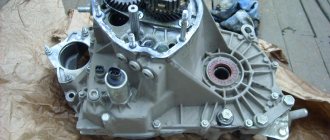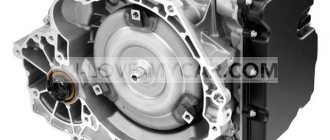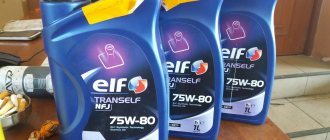Changing the oil in the gearbox on a Hyundai Accent should be carried out depending on its type, the load on it during operation, as well as the use of the vehicle.
On average, you need to change the oil every 90 thousand km for automatic transmissions, and 100 thousand km for manual transmissions
For automatic transmissions, the time from replacement to replacement is much shorter. It is recommended to change them approximately once every 90 thousand kilometers. But if you rarely drive your car, then the change is carried out every six years.
If your car has a manual gearbox, it should be replaced once every 100 thousand kilometers. Also, if the machine is rarely used, it is recommended to replace it once every seven years.
As you can see, the mechanics are less picky. This difference is due to the fact that the manual transmission is more durable.
Timely oil changes prevent premature wear of parts
How to check the oil level in a Hyundai Accent manual transmission?
The order of work should be as follows.
Drive the car for about 20 km and place it on a viewing hole or overpass.
Remove the oil filler plug - the fluid level should be at the edge or slightly lower.
Close the plug, place the car on a level horizontal surface and press the brake pedal. At idle, move the selector lever from P to other positions, and then return it to its place.
Remove the dipstick and evaluate the current performance. The oil level mark should be between “Cold” and “Hot”.
Selecting manual transmission oil for replacement
When choosing a lubricant for changing your Accent manual transmission, you need to consider a number of the following aspects:
- car mileage;
- oil that was previously used to lubricate parts;
- temperature conditions of vehicle operation.
If the mileage of your car is very high and the rubber components of the gearbox no longer have their original properties, then using a synthetic lubricant does not make sense. Also, if mineral lubricant was previously used to lubricate gearbox parts, then before changing the seals there is no point in using synthetics because there will be a 100% leak.
Among modern manufacturers of automotive chemicals, products from the following companies are suitable for Hyundai Accent: Castrol, Liqui Moly, Motul, Ravenol, as well as original lubricant from the manufacturer Hyundai/Kia.
Quality standard
What kind of oil to pour into the box of a VAZ-2110
There are certain markings that can be used to determine whether an oil meets a particular quality standard. For example, according to the American API standard, there are two groups of oils - GL4 and GL5. Fluid marked GL5 has many more useful additives that provide extreme pressure properties.
In addition to GL4 and GL5, there is also the marking GL4/5, which indicates a universal type. Another quality standard is the so-called SAE. It is used to determine the viscosity-temperature properties of the oil. The SAE standard also has different markings, for example 75W90. Oil with this viscosity is considered the best option for not too cold winters, and is also suitable for high temperatures.
Step-by-step procedure for changing oil in a manual transmission
Draining old oil from a manual transmission in a Hyundai Accent occurs according to the following scheme:
- The car is placed on a flat surface. To do this, it is recommended to use an inspection hole, a lift or an overpass.
- The gearbox housing is wiped with a rag around the drain and filler holes.
- Place a container with a volume of 3-5 liters under the hole.
- The drain plug is loosened and an empty container is placed under it.
- The oil is drained into a substitute container. The sealing ring of the drain plug is replaced (if necessary). The plug is tightened with a torque of 35-45 Nm.
Washing the pan:
- Unscrew the pan. Carefully drain off any remaining oil. Clean the surface with a wire brush and wipe with a clean cloth.
- Screw the tray back on.
Step-by-step instructions for filling new oil in a Hyundai Accent manual transmission:
- Unscrew the filler plug with a 17 key.
- Fill in new transmission oil with a syringe to the required level.
- Tighten the filler plug with a 17mm wrench.
- Start the car, drive a test 10-15 kilometers and re-install the vehicle on a flat surface.
- Check the oil level and top up if necessary.
It is necessary to check the oil level once every 10 thousand kilometers. The procedure helps to find leaks if they appear. You can control the oil level through the inspection hole.
Complete automatic transmission oil change - logbook of the 2008 Hyundai Accent AT InFinity on DRIVE2
It's time to change the oil in the box; according to the regulations, this needs to be done once every 90 thousand km. At this point, I have no complaints about the operation of the box, it works like a clock. Many people change the oil in automatic machines partially: they drain what is in the pan of the box (about 50%) and add this volume through the screw. In this case, the new oil is mixed with the old one, and after 15-20 thousand, the procedure is repeated again.
In this way, the oil seems to be renewed. I didn't want to go this route because...
With this method, there is no way to replace the oil filter, clean the magnets, and after some time you will need to change the oil again, so it was decided to change it completely.
This procedure can be carried out in the garage, but only if there is a hole and a couple of extra hands. I turned to a service center where they change the oil by displacement through a special device.
I did it at the “Express” technical center on Leningradsky, 18, there is even a website: “Express” technical center. They have different types of oils in stock, mostly the most popular ones.
For example, I was asked to fill up with Castrol Transmax ATF at a price of 475 rubles per liter.
Technical center on Leningradsky, 18
As you know, our automatic transmission accents have a Mitsubishi A4AF3 gearbox, so I decided to fill in what was prescribed by the factory - Mitsubishi DIAMOND ATF SP-III, especially since I can buy this oil much cheaper through the online store of my good friend Al-parts - 230 rub. per bottle 946 ml. (almost a liter
Selection of oil fluid and required tools
Today there are many different lubricants for Accent gearboxes. They are divided into categories according to the accepted specifications. You need to be able to choose the right lubricant for a particular car.
If you read the operating manual, you can understand what consumables the car manufacturer recommends to put into the Hyundai Accent automatic. These are Mitsubishi Diamond SP-3 and ZIK SP-3. The car manufacturer is not responsible for the consequences of using oil fluids other than those specified.
The frequency with which it is necessary to change the oil in the Accent manual transmission is ninety thousand kilometers or once every six years. It is advisable to use “Hyundai Genuine Pats 75w85”, “TGO-7”, “ZIK GF TOP 75w85”.
To change the oil in an automatic/manual transmission you will need:
- pallet cover;
- sealant;
- Hyundai oil filter;
- funnel;
- fuel hose;
- flat screwdriver;
- key "for seventeen";
- thin ten-point wrench with extension;
- hammer;
- wooden beam;
- buckets for old grease.
Oil change period
The gearbox oil of a Hyundai Accent needs to be changed every 50-60 thousand km to avoid overheating of the gearbox and difficult gear shifts. In harsh conditions, more frequent oil changes cannot be ruled out, the quality of which deteriorates over time due to the loss of beneficial properties. So, we are talking about the protective functions of the oil, which protect the box parts from corrosion and oxidation processes, dirt deposits and metal shavings. In addition, the oil also performs a cooling function, protecting the hot gearbox components from increased dry friction and overheating. Finally, high-quality oil effectively lubricates parts through a durable oil film that ensures smooth gear shifting under any low- or high-temperature loads. Thus, if not replaced promptly, these three important functions of the oil (protective, lubricating and cooling) will be lost, and as a result the transmission will be subject to excessive wear.
How much oil to fill
First generation X3, 1994-1999
The emphasis of the first generation replaced the Hyundai Excel, although the former Excel name was retained for the Netherlands and Australia, and the Pony designation was current in France. The car did not have a sophisticated design and looked like a typical budget sedan, although three- and five-door hatchbacks had a more youthful appearance. In general, the body, almost devoid of sharp lines, was considered quite modern. In addition, the car became popular due to its high maintainability and low cost, which was very important for the Russian market in the era of the 90s. The interior of the car, like the exterior, is also made in rounded shapes, relevant at that time. The most expensive versions of the Accent had air conditioning, power windows, power steering, airbags and an automatic transmission.
Manual transmission oil: volume – 1.9 liters with partial replacement
Second generation LC, 1999-2012
The accent of the second generation, in contrast to its streamlined predecessor, was, on the contrary, distinguished by straight forms, due to which the body was more proportional. In addition, the internal space has already increased, and the wheelbase is 2440 mm (previously it was 2400 mm). In 2003, a facelift took place, affecting the front part of the body, and also bringing a new LC2 index in the model designation. The 2nd generation Accent engine range consisted of new gasoline engines: a 12-valve SOHC with a volume of 1.3 liters, as well as a 16-valve DOHC with a volume of 1.5 liters. A 1.5 liter three-cylinder CRDi diesel was also available. The top versions were offered in Europe and North America, for which after 2003 a 1.6-liter engine became available. Production officially ended in 2006, but in Russia this model continued to be assembled until 2012.
Manual transmission oil: volume – 1.9 liters with partial replacement
Also read: Oil for manual transmission Kia Spectra
Checking the automatic transmission oil: level and condition of ATF fluid in the box
Automatic transmissions on modern cars are confidently pushing aside the usual “mechanics”. The reason is obvious, since this type of transmission greatly simplifies and facilitates the driving process. Also, automatic transmissions are quite reliable. The main thing is to follow the basic operating rules, as well as timely service the automatic transmission.
In this case, maintenance should be understood as checking the oil level in the automatic transmission, assessing the condition of the transmission fluid, as well as regularly replacing the ATF and automatic transmission filter. Next, we will talk about how to properly check the oil level in an automatic transmission, as well as what to pay attention to when checking the condition of the oil in the box.
Why do you need to check the oil in an automatic transmission?
Let's start with the fact that any gearbox (mechanical, robotic, hydromechanical or CVT) requires the use of gear oil. In the case of “mechanics” or “robots,” transmission oil acts as a lubricant, protects loaded parts, washes away wear products from surfaces, etc.
THIS IS INTERESTING: How many liters of oil are in an 8 valve engine
The oil also circulates through the channels of the valve body under pressure, thereby forcing the desired gears to engage due to the effect of the fluid on the clutch packs (this is how the automatic transmission is controlled).
It is quite obvious that in a hydromechanical gearbox the requirements for the level and quality of oil are significantly increased. In this case, the owner must constantly monitor both the ATF level in the gearbox and the condition of the fluid.
Ignoring these recommendations can lead to a shortened service life, the appearance of jerks and kicks when changing gears, as well as unexpected failure of the automatic transmission.
It is important to understand that most automatic transmission malfunctions occur as a result of a decrease in the oil level in the box. Also, a situation often arises when the level exceeds the permissible norm, which also has a detrimental effect on the condition, quality of work and resource of the “machine”.
In some cases, the culprit is a simple mistake or incorrect measurement of the oil level in the automatic transmission. In other words, you need to know how to check the oil in an automatic transmission, and do it correctly.
Oil level in automatic transmission: how to check
First of all, to check the oil level in the automatic transmission, it is recommended to separately study the operating manual for the specific vehicle. The manual usually contains complete information on how to correctly measure the automatic transmission fluid level, what volume of oil to pour into the automatic transmission on a particular car model, what ATF is recommended to use, etc.
So, as for the general recommendations that are relevant for the vast majority of cars with automatic transmission:
- The oil level in the automatic transmission is often checked to see if it is “hot”. This means that not only the engine, but also the transmission must be warmed up to operating temperatures. To fully warm up the “automatic” you need to drive about 20-25 km.
- Next, the car is placed on a flat surface, the automatic transmission selector is switched to “parking” mode (P), and there is no need to turn off the engine. The engine should be allowed to idle for 3-5 minutes.
- Then you need to pull out the automatic transmission oil dipstick and wipe it with a dry, clean rag. Make sure that there is no lint or other debris left on the dipstick. After this, the probe must be reinserted until it stops for 5 seconds. and re-extract. As a rule, the dipstick has Cold and Hot marks. The first mark allows you to make a rough check of the cold level. This is usually necessary when changing the oil in an automatic transmission.
- The second mark requires an accurate check after the oil in the box has warmed up. Normally, after warming up the automatic transmission, the ATP level should be between the Cold and Hot marks. Significant deviations are not allowed, either downward or upward.
Checking the oil level in an automatic transmission: useful tips
Note that the dipstick for checking the oil in an automatic transmission is usually red, while the dipstick for checking the oil level in the internal combustion engine crankcase is yellow. It is also advisable to wipe the neck before removing the dipstick to prevent dirt from getting inside the box.
Please note that if the level after warming up the automatic transmission is maximum (closer to the Hot mark) or low (located at the Cold mark), then the oil must be either topped up or pumped out. In both the first and second cases, ignoring this recommendation can lead to malfunctions, increased wear and breakdown of the automatic transmission.
If the oil level in the automatic transmission is below normal, then:
- A violation of the temperature regime occurs, the fluid loses its properties, and the risk that the automatic transmission oil pump will capture air increases, which will lead to foaming of the transmission oil. The result is that the pressure in the system will drop, as the foamed liquid will compress. Low ATP pressure, in turn, leads to malfunctions of the automatic transmission, overheating of the gearbox, accelerated wear, etc.
- If the oil level in the automatic transmission is too high, then the liquid may also foam as a result of contact with the rotating elements. In this case, the consequences will lead to similar results as in the case of reducing the level below the recommended level. Also, the foamed liquid will increase in volume, the excess will come out through the box breather, which will lead to oiling of the automatic transmission.
Let us also add that it is a mistake to consider the Cold level to be the minimum indicator for a warm automatic transmission. A decrease in the ATF level in the box after warming up to this level indicates an urgent need to top up the transmission fluid.
As for foaming, when checking on the dipstick you can see individual large air bubbles. If the ATP level is normal, then this does not indicate that the oil in the box is foaming. If the level deviates from the norm and the oil is foamed, then such foaming appears in the form of small and evenly distributed bubbles.
In this case, the car engine must be turned off for 15-20 minutes. During this time, the oil in the box settles, then the level is checked again with the engine turned off. Afterwards, the appropriate manipulations are performed, that is, liquid is added or excess is pumped out. The main task is to bring the ATF level in the automatic transmission back to normal.
- When checking the level, be sure to evaluate not only the level, but also the condition of the working fluid itself. The ATF fluid must be checked for contamination, changes in color and odor. Normally, transmission oil is reddish in color, transparent, and has a characteristic odor.
If, for example, dirt particles and metal shavings are noticed on the dipstick, then this indicates that there is significant mechanical wear in the box. A change in the color of the fluid from red to brown, obvious darkening or blackening indicates overheating of the oil in the automatic transmission. A distinct burnt smell often indicates that the clutches of the automatic transmission are slipping and “burning.”
One way or another, the contaminated fluid needs to be replaced. At the same time, the automatic transmission filter is also changed. At the same time, changing the oil in an automatic transmission should be carried out only taking into account the requirements of the car manufacturer itself. If you fill in ATF that is not suitable for its properties, then this can lead to breakdowns of the automatic transmission and expensive automatic transmission repairs.
THIS IS INTERESTING: How to check the coolant level in Solaris
Let's sum it up
As you can see, checking the oil level in an automatic transmission is not a complicated procedure and can be done independently. In this case, you should not only adhere to the basic recommendations, but also note that some car models with automatic transmission may have not two marks on the dipstick, but only one.
There may also be some differences in the method of checking the oil level in the automatic machine. For example, some manufacturers recommend checking the oil level in the gearbox “while it’s hot,” but the engine must be turned off. Before checking, you may also need to put the car not in “parking” mode, but in neutral gear N.
We also recommend reading the article about how much it costs to change the oil in an automatic transmission. From this article you will learn about the available methods for changing transmission oil (full and partial), as well as how much it costs for automatic transmission oil, an oil filter, and what the cost of replacement work is. For this reason, it is highly advisable to first study the operating manual for a specific vehicle or obtain qualified advice from specialized specialists. We also note that different types of gear oils may differ slightly in color and smell. However, regardless of the type of liquid, the oil must be clean and transparent, without foreign impurities, metal shavings, foam, burnt odor, etc.
It is highly advisable to remember what color the fresh fluid was during replacement, and then note any possible changes during checks. If any were noticed, then it is better to take the car to a service center and have the automatic transmission diagnosed.
Source: https://krutimotor.ru/proverka-urovnya-masla-v-akpp/
Replacement algorithm
Automation
It is worth noting that it is possible to change the oil in a Hyundai Accent automatic transmission either completely or partially. Next, you can familiarize yourself with the full shift algorithm. It looks complicated, but in reality the procedure is quite easy, although it takes a lot of time. To make it easier to change the oil in the box yourself, you can call a partner.
Mechanics
- Warm up the internal combustion engine.
- Place the machine on a ditch/overpass.
- Place a bucket under the drain.
- Unscrew the drain cap using a twenty-four wrench.
- While the old oil is pouring out, clean the drain cover and change the washer.
- Screw the cap with a force of 30-35 Nm.
- Unscrew the oil filler cap.
- Using a syringe or funnel with a hose, pour fresh consumables into the gearbox.
Replace the washer, close the lid. The tightening force should be 25-30 Nm.
Hyundai Accent, produced at the TagAZ plant in 2001-2012, was equipped with a 1.5-liter 16-valve engine producing 102 hp, 5-speed manual or 4-speed automatic transmissions.
The automaker recommends changing the oil in the Accent gearbox at least once every 90,000 km in cars with both manual and automatic transmissions. What kind of oil to fill into the Accent gearbox when replacing depends on the type of transmission.
Why change?
Of course, nowadays manufacturers of automotive chemicals conduct a lot of research and present a fairly high-quality product on the market. But due to the characteristics of the chemical components of different types of lubricants, over time the oil loses a number of its properties and does not fully perform its functions. Gearbox lubricant is no exception; over time, it also needs to be replaced.
After the loss of some properties of the lubricant, metal ones are not protected from mechanical damage during friction. It is also important that due to the same friction, a sediment of small metal particles appears in the oil, which subsequently have a detrimental effect on the internal mechanisms.
What Oil to Pour into a Hyundai Accent Box
Transmission oil is designed to prevent mechanical wear inside the gearbox. At a minimum, by using quality ATF, you can at least avoid early wear on transmission components
This is why it is very important that the fluid meets all specifications in the annotation and is compatible with the Hyundai Accent. Failure to comply with at least one of the rules can lead to irreversible consequences immediately before the failure of the entire gearbox
Therefore, the main function of the oil is to prevent wear of parts in the gearbox.
- Synthetics. best option for Hyundai Accent. This is a rarer, rarer oil that is never refrigerated. This makes it a good option when working in frosty conditions. Synthetic lubricant consists of environmentally unalloyed impurities. So these are mainly light hydrocarbons and natural compounds of natural origin. Synthetic has the most versatile viscosity grade, making it suitable for any climate. The main disadvantage of synthetic oil is definitely the highest price.
- Semi-synthetic. the best lubricant, the main components of which are synthetics and mineral oil. To be more precise, this oil is obtained by mixing both types of oil in a ratio of 30 to 70 in favor of mineral oil. This method can significantly reduce the cost of goods. However, such oil will not be the best choice, even for a cheap foreign car such as the Hyundai Solaris. On the other hand, choosing semi-synthetics will only be justified if the car is very long
- Mineral oil is the most affordable of all lubricants presented. It is used only on old cars with high mileage. This is not only the most affordable, but also the thickest oil. Because of this, it is not recommended to fill it at low temperatures.
There are certain guidelines that can be used to determine whether an oil meets a specific performance standard. For example, according to the South American API standard, there are two groups of oils. GL4 and GL5. Fluid labeled GL5 contains even more additives that provide exceptional pressure properties. In addition to GL4 and GL5, there is also a GL4/5 marking which indicates the universal type. Another proprietary standard is the so-called SAE. Determines the viscosity and temperature characteristics of the oil. The SAE standard also has various markings such as 75W90. An oil with this viscosity is considered a good option for not very cool winters, and is also suitable for high temperatures.
Lukoil TM4 / TM5 with viscosity settings 75W90 or 80W90. balanced option for a manual transmission. This oil is reasonably priced and has good resistance to wide temperatures. Lukoil TM4 / TM5. one of the best semi-synthetic oils on the world market
- ZIK G-FTop 75W90. This is a synthetic oil that in 2022 was recognized as the best product in its price category. This oil has excellent protective, antifriction and extreme pressure characteristics. Moreover, the price of this product is not very high compared to premium brands.
- Castrol Syntrans Transaxle 75W90 is another balanced option for the Hyundai Accent. The beneficial characteristics of this oil have a positive effect on the cooling component of the box. With this lubricant, the box will not overheat and will always please the owner with clear switching in time. Has good anti-scuff properties.
- Liqui Moly Hypoid-Getriebeoil TDL 75W90. semi-synthetic semi-synthetic oil class GL4 / GL5. It does an excellent job of cooling gearbox components, preventing them from overheating, and ensuring smooth and precise gear shifting. The advantages of this oil are its excellent heat resistance and corrosion resistance.
Hyundai Accent. It is an economical foreign car, but this does not mean that any oil is suitable for its gearbox. As we can see, the choice of oil. a complex procedure that requires knowledge of various characteristics. for example, degree of viscosity and compliance with certain property standards. All relevant specifications are contained in the Hyundai Accent data sheet. By inspecting them and choosing the right lubricant for the gearbox, there will be no problems with the Hyundai Accent.











